Let me tell you this straight out. Jaeger-LeCoultre has a richer history than most other watch brands on this planet.
Not only was it founded before many other high end watch brands like Patek (1839) and Audemars (1875), but Jaeger can rightfully boast about its extraordinary role in watchmaking. If you delve into their history, you find out that the firm founded by Antoine Le Coultre and Edmond Jaeger, were way ahead of their time.
Through their technical prowess – they supplied other leading watch brands of the time, Cartier, Patek, Audemars, Chopard etc. Name any high-end watch brand and you can be pretty sure Jaeger-LeCoultre supplied them with their movements. It is not exaggeration to say that they enabled many Iconic brands and models (like the Cartier tank) to succeed.
They were the watchmakers of watchmakers.
In order to find out more about Jaeger and their rich history – we sat down with Stephane Belmont who is head of their heritage department and has spent his almost entire career at Jaeger-LeCoultre in various departments, from director of product and development, to director of marketing and communication and then director of marketing and creation. There is simply no better person to talk to – about this legendary company.
Let’s get started.
In your words – the DNA Jaeger-LeCoultre is the following….?
Stephane: Our DNA is that of being a watchmaker to the watchmakers.
Most of our movements supplied to other brands led to their success of those models. Also Jaeger became successful due to their ability to be good at making mechanical movements but also being good at design and aesthetics. Both were equally important at Jaeger. Our ability was always to make exceptional products that was more important than the brand itself.
A good example was also making car instruments. Jaeger made the best counters in the world and nobody wanted to race a car if the instruments were not Jaeger based. Bugatti, Delahaye, Talbot Lago, Delage, Voison – the most beautiful cars in the world used Jaeger.
Jaeger has made more Iconic watches than most other watchmakers: Reverso, Atmos, Memovox Polaris, Memovox, Deep Sea, Futurematic, and Geophysic. What explains this?
Stephane: Jaeger created so many iconic watches – because the brand is always looking at the future.
The future was as important as the past. Jaeger was always searching for functional innovations. Let me give you a few examples of what I mean: The Atmos, is a good example of this. So was the Reverso. The Reverso which was among the first elegant wristwatch with a case that swivelled. The Memovox Deep Sea being the first diving watch that used sound as a time measurement instead of only the rotating bezel. The Futurematic being one of the first watches to take advantage of the automatic movement by removing the winding crown.
Jaeger always risked to dare and create inventions that were different to what others were making.
For me the Reverso is one of the greatest watches ever made: How important is this model in your history?
Stephane: As you can imagine the Reverso was a crucial model for us. So much so that if it would not have been for the Reverso, Jaeger-LeCoultre as it stands today would not exist. In the beginning our watches were sold under different names, the success of the Reverso allowed us to create a distribution company, that would carry from, 1937, both names, Le Coultre and Jaeger.
What led to the success of the Reverso?
Stephane: The Reverso was a timeless design with extremely functional use. In the period when the Reverso was introduced in the 1930s, the rectangular shape, was considered the most elegant, more elegant than round watches. It was seen as a continuation of the strap of the watch. Elegant and sophisticated and very playful with the case that swivels around. It was the first three dimensional watch, this playful usefulness (the case can swivel to protect the watch) made it an Icon.
Can you tell me more about a QP Reverso that never made it into production?
Stephane: Sure. The QP (Quantieme Perpetuel or perpetual calendar) never made it into production at Jaeger but we have records and know that it was sold to other manufacturers. The movement 424, which was the same movement without the perpetual function, was made for 10 years and used for the Reverso.
Jaeger has a rich history of supplying other brands with their movement. Is this a big advantage for the brand?
Stephane: This technical know-how, allowed to create many different movements for many brands. This ability to help brands, for example in making very small movements for ladies, allowed us to explore many possibilities and supply brands such as Cartier, Van Cleef, Chopard etc. Our ability to always innovate and look forward led to us being a ‘watchmaker to the watchmakers‘.
Do you see the vintage side of your business growing?
Stephane: Yes the vintage side of our business is growing very fast. We are busy issuing certificates for our vintage watches, reparing old watches that customers send in. We are lucky in that 95% of the time we can tell from what year our watches come from by looking at our extensive archives.
How important is the museum in explaining the history of the brand?
Stephane: It is particularly important for our European and American clients. But also for our Asian clients. Clients in general want reassurance that what we make today, in terms of models, is also sustainable. For example when we show our smallest mechanical movement, caliber 101, which we still produce in a few units, clients can see that we have a huge history and continuation in what we do.
For example, the smallest movement, caliber 101, was also worn by Queen Elizabeth at her coronation in 1953 in Westminster Abbey. So, the fact that we still produce a few of those movements a year is not meaningful in terms of output, but is a huge asset to our image.
Women appreciate that we are still making a movement that was introduced more than 60 years ago – and many women are inspired by our history.
What piece or pieces are you most proud of in the museum?
Stephane: We have a lot of incredible pieces in the museum. But one of the more special pieces is the Geophysic of , Commander Anderson, which the widow accepted to sell to us after this death 18 months ago.
What piece still eludes you?
Stephane: Of course the perpetual calendar Reverso – we have the movement but don’t know or have not found the Reverso it belonged to. Also we had a Reverso with a wonderful enamel engraving on the back of an Indian beauty. It would be nice to discover who this lady was and we are still doing our investigations on this particular watch.
Else, as you have seen yourself, the museum has a lot of Iconic pieces that well explain the history of Jaeger-LeCoultre.
Is the museum still active in buying pieces for the museum?
Stephane: As you know a recent purchase is, the General McArthur Reverso , which we recently bought. But we generally have been quite active, we have an employee dedicated team, to help us be more efficient in our heritage department and in identifying watches that come to us.
Today we are still buying masculine pieces but we are trying to get more into our women watches which we did in the past. We have made some incredible women’s watches, (like this watch which inspired Hermes) – and want to be inspired by what has been designed in the past.
Jaeger has been very good at paying tribute to their heritage. Polaris re-edition, Deep Sea Alarm etc.
Stephane: I think our success in bringing out re-editions of our icons is explained in the following way: Not only do we rely on our rich history but also we are using the same movement or the descendant of the original movement. We just improve upon it and tried to make it better, more reliable but we are always using the original movement as a base. Collectors appreciate this.
We are also pay close attention to the quantity we make as we don’t want to over flood the market. This is another thing collectors appreciate. For example we make only 1300 Polaris re-editions which is also more or less how many of the originals were made. And we choose only to make re-editions when the piece has a very strong design and is important in our history.
(I would like to thank Stephane Belmont for his generous time and exceptional knowledge and also Cecile Tinchant for organising this interview).
Let us go through some pictures that explain the rich history of Jaeger-LeCoultre. Once you step inside the museum and heritage gallery you notice the large rooms with the archives.

Where you find documents like the patent for the Reverso.
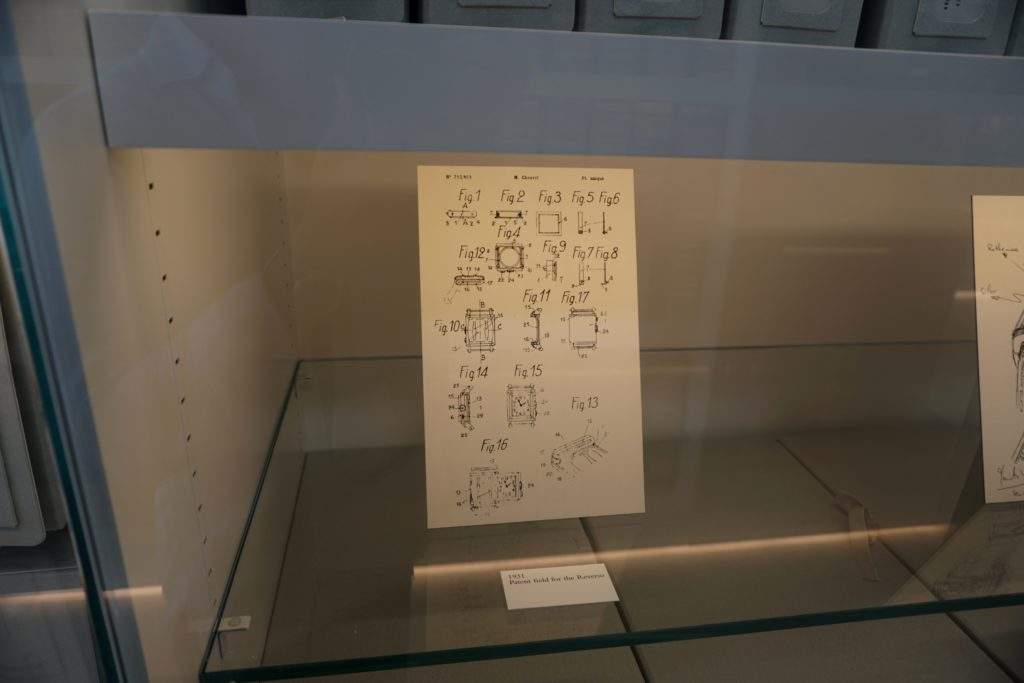
And old advertisements for the Reverso.
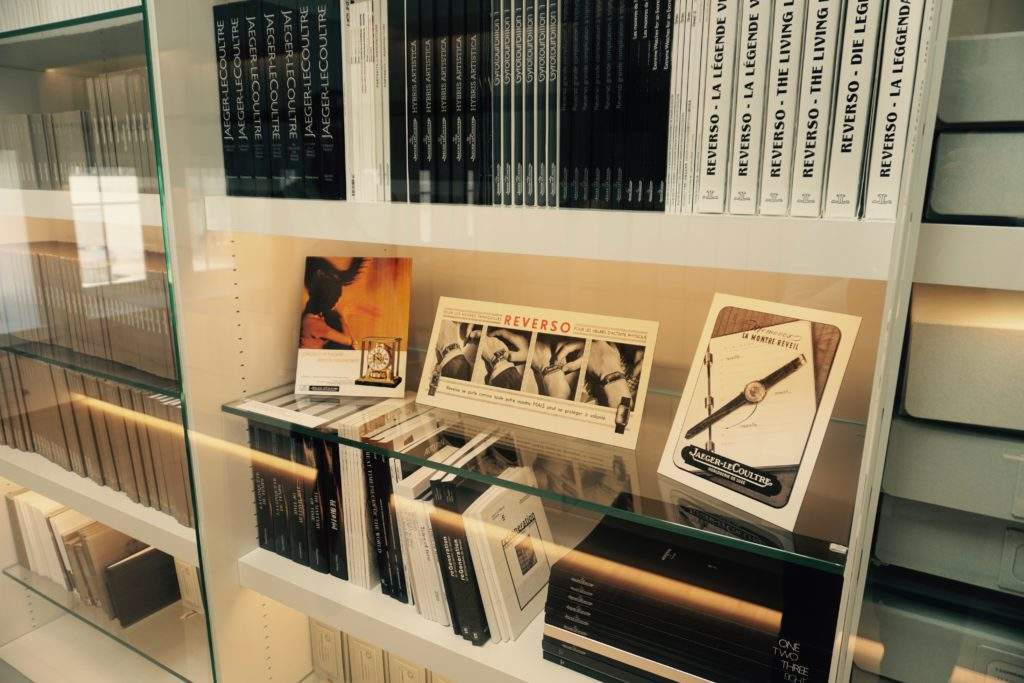
Let us look at the advertisement you see in the window above- in more detail below.
To translate: the Reverso is perfect for quiet moments, but also for moments where the owner is active. The Reverso is like most watches, except, you can also protect the Reverso at any time you want.
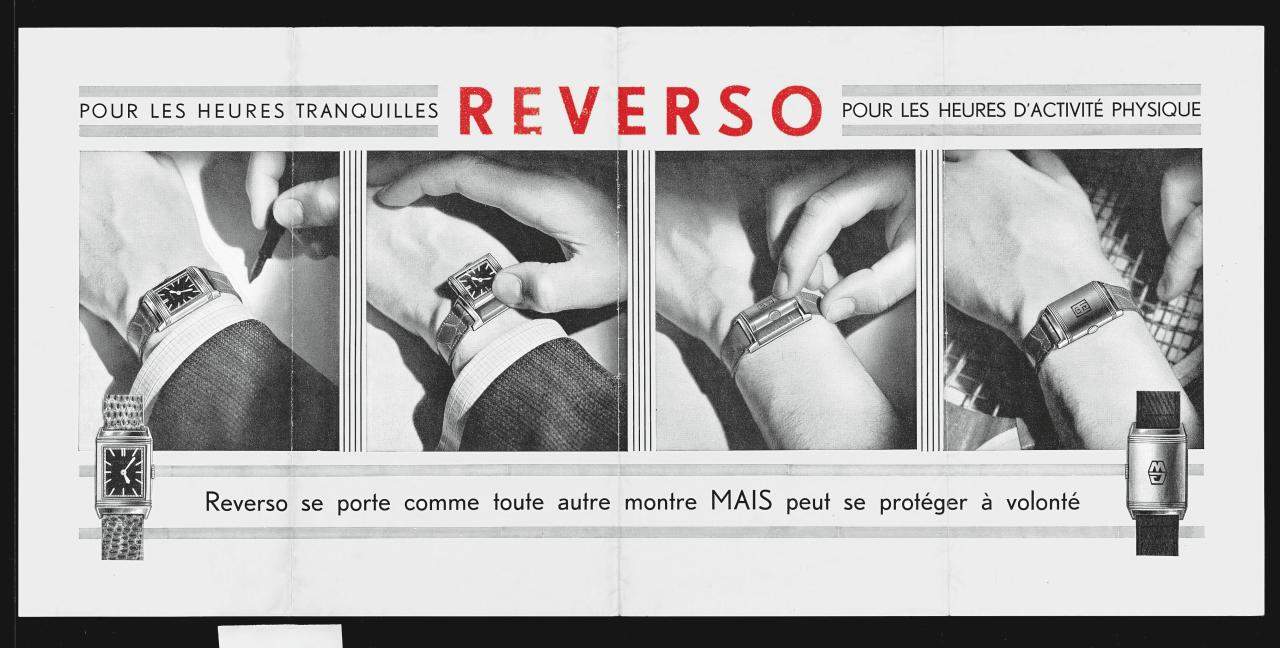
Jaeger-LeCoultre has a great archive history and they can trace 95% of their watches that were sold historically – a service the heritage department offers.

On the other side of the Museum, the history of Jaeger-LeCoultre is explained in pictures and watches.
Below one of the founders, Edmond Jaeger, who was a watchmaker by training and it was he who had the vision and pushed Jaeger to make ultra small movements.
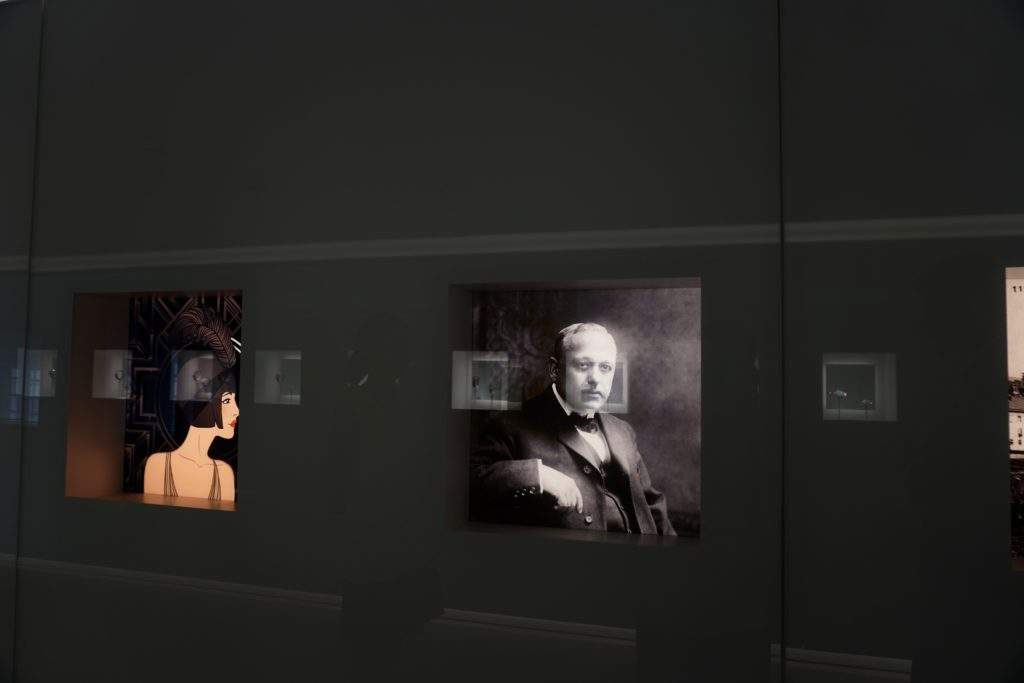
When I said Jaeger was the ‘watchmaker to the watchmakers‘ – it was not exaggerated. Below a Patek pocket (circa 1900) watch made for Tiffany – with a Jaeger calibre inside.
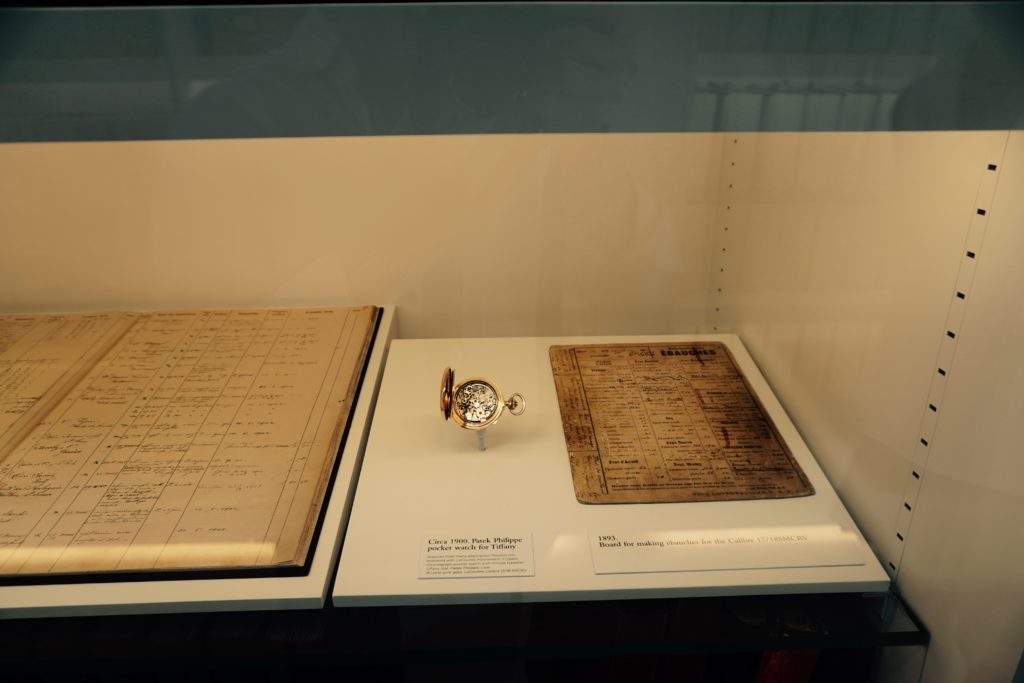
Jaeger’s technical ability and strength allowed Cartier to be the very first watch to use a folding clasp -which was patented by Edmond Jaeger. (Credit: Cologni – Cartier the tank watch).
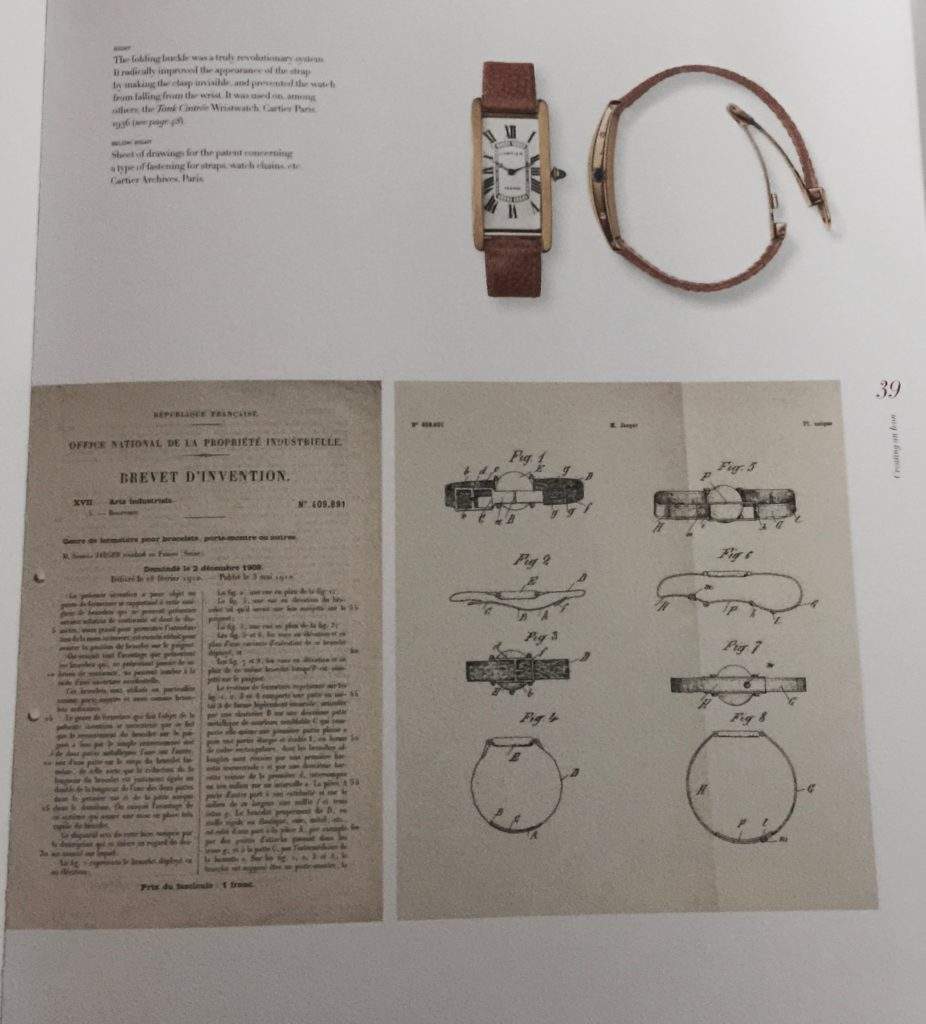
Jaeger-LeCoultre made some of the smallest women watches in the world using its movement, calibre 101.
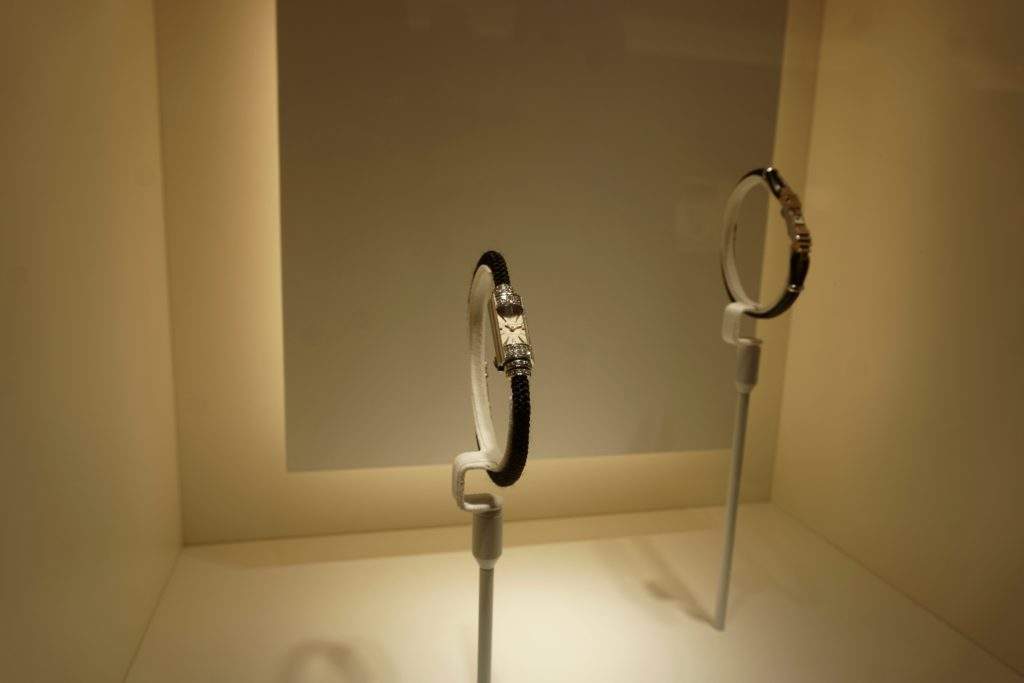
(Credit: Jaeger-LeCoultre).
Jaeger’s strength lay in making great technical movements combined with great style and shapes. They were very successful with women watches.
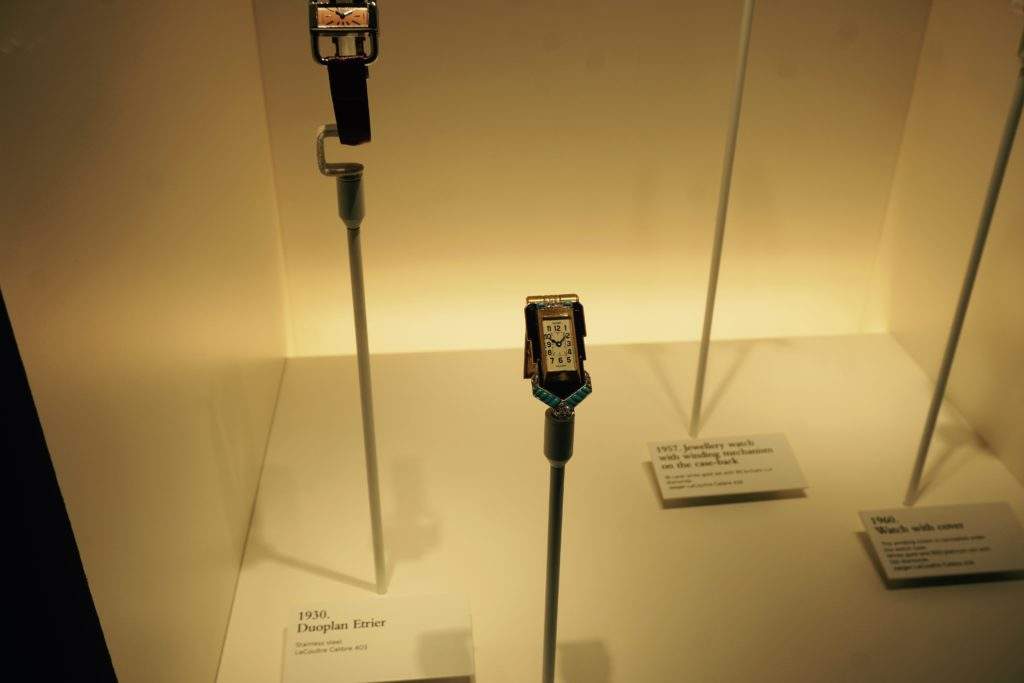
Below a closer look at the Duoplan watch set made for women.
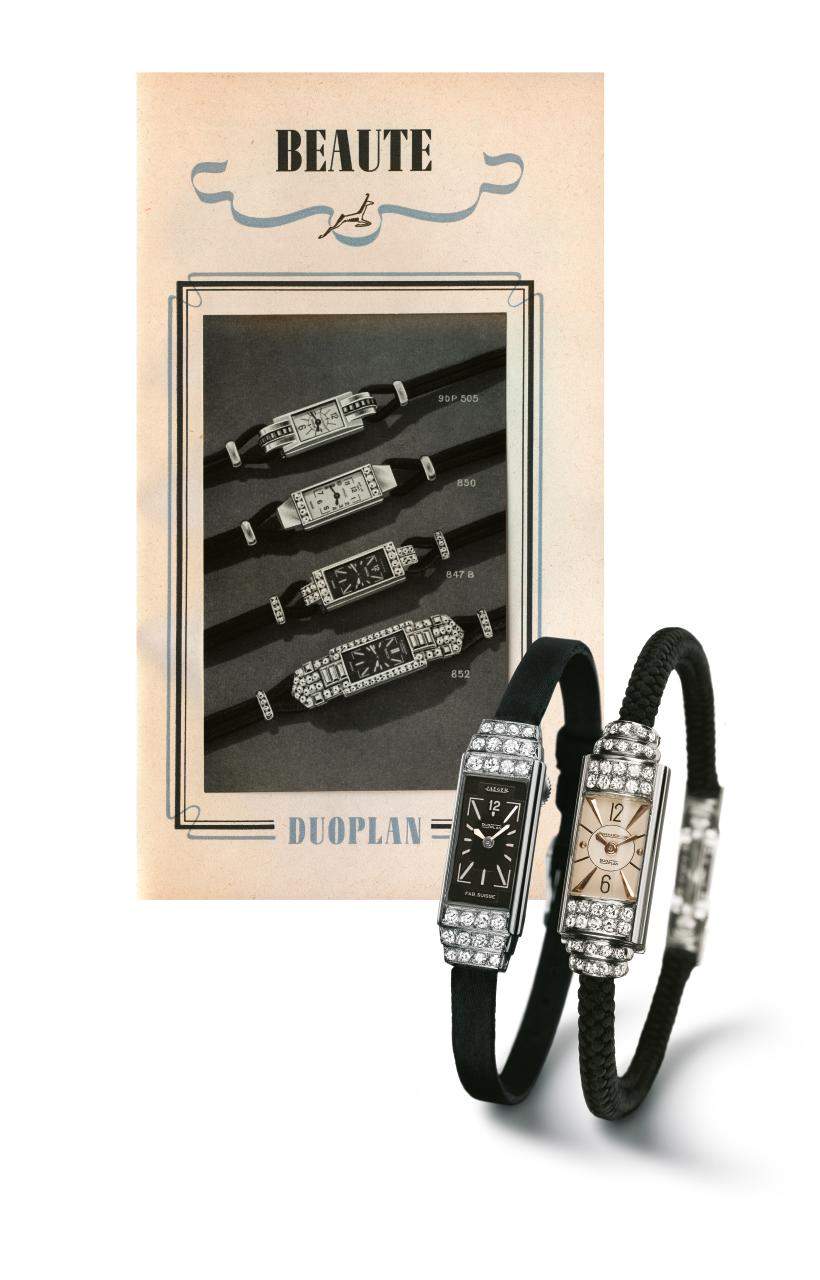
(Credit: Jaeger-LeCoultre).
They also made designs that would be used be Hermes later on. The watch below is a so-called Duoplan ‘Etrier’ watch.
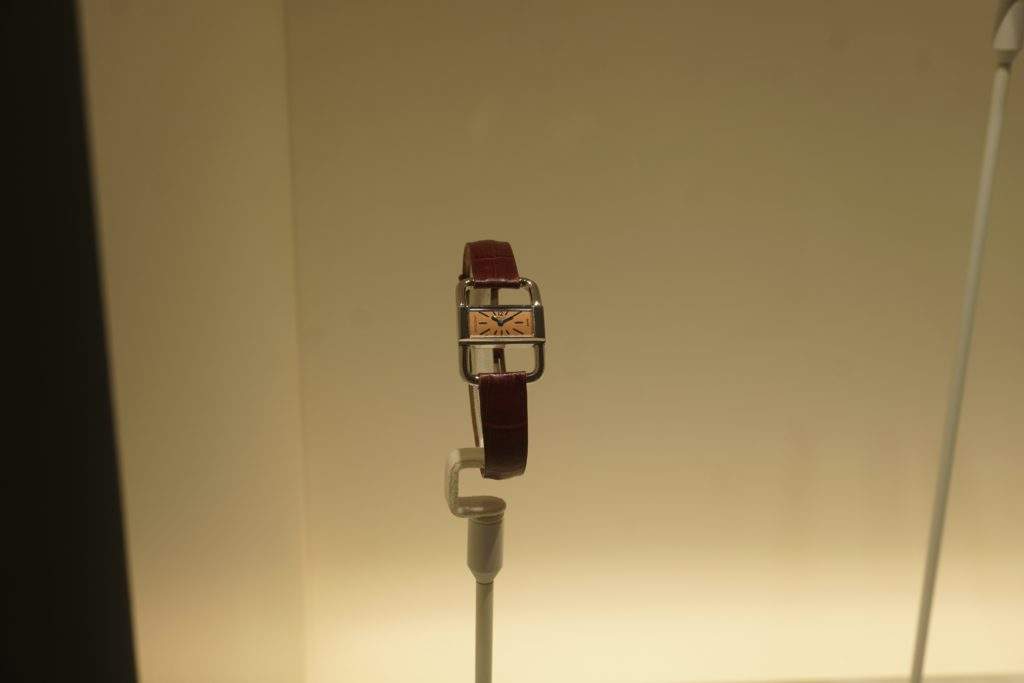
Before sector dials would be popular in the 1940s, Jaeger was making them in their pocket watches in the 1930´s already.
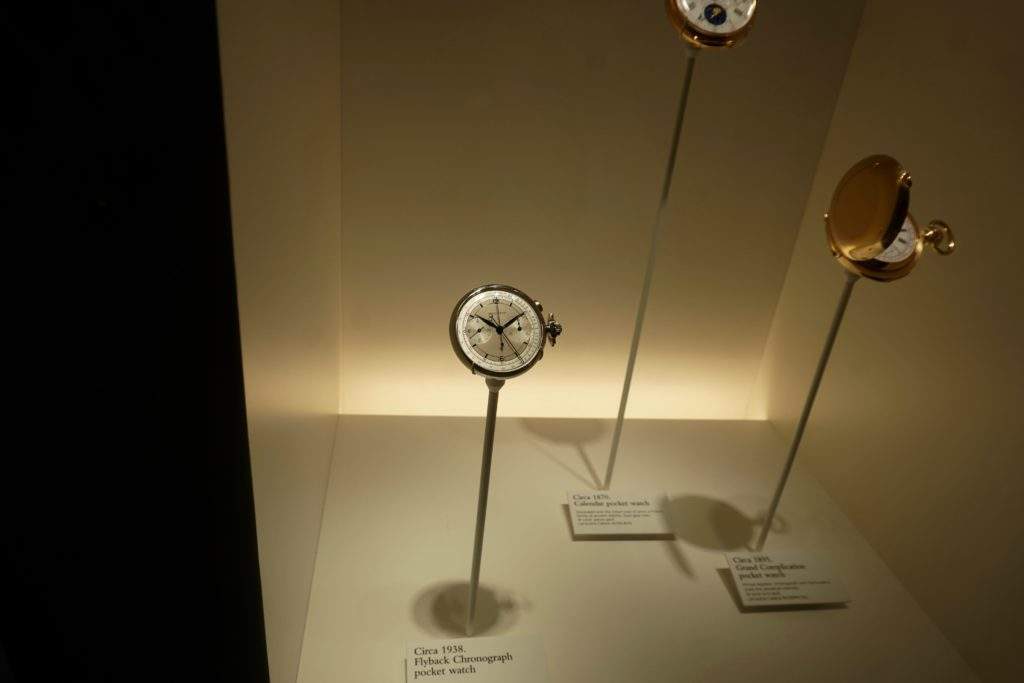
During the 1930s onwards, Jaeger also made car instruments- that were considered the best in the world.
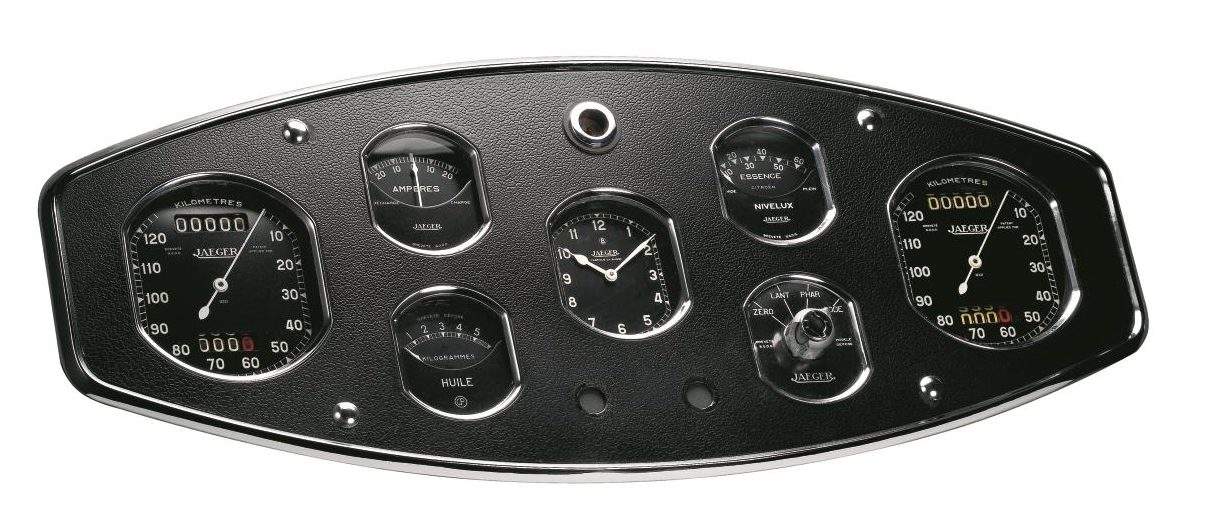
(Credit: Jaeger-LeCoultre).
Below the Ferrari of Agnelli who had a special Jaeger 8 day clock installed. Bugatti, Delahaye, Talbot Lago all used Jaeger instruments.
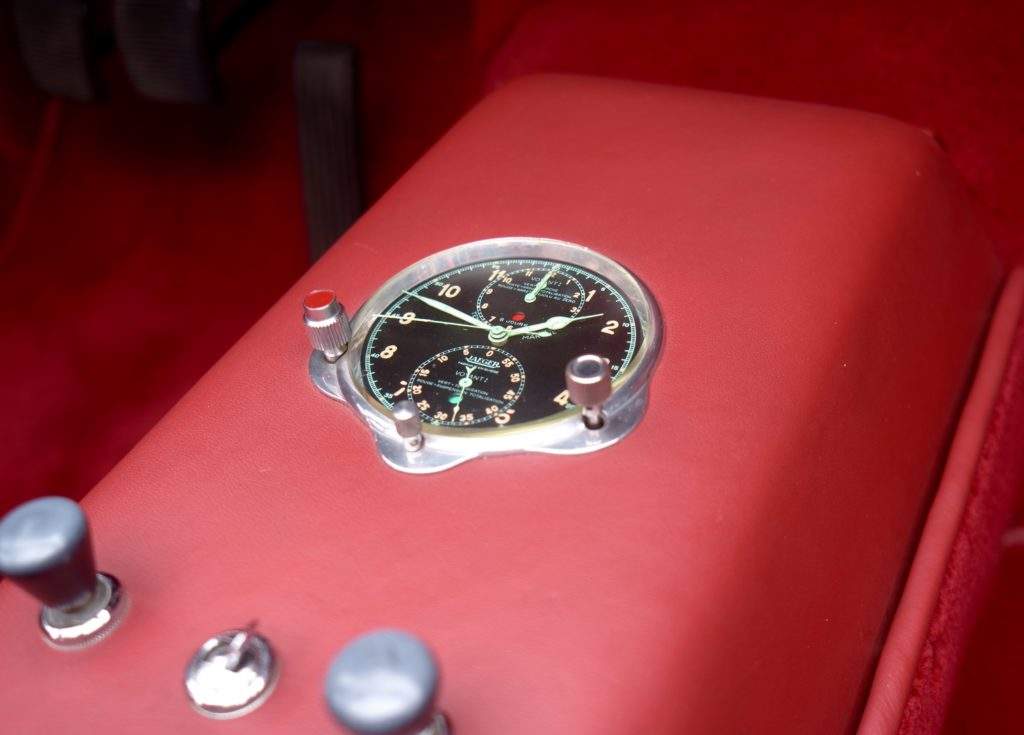
Then in the 1930s, came the most famous watch ever to leave the house of JLC – the Reverso.
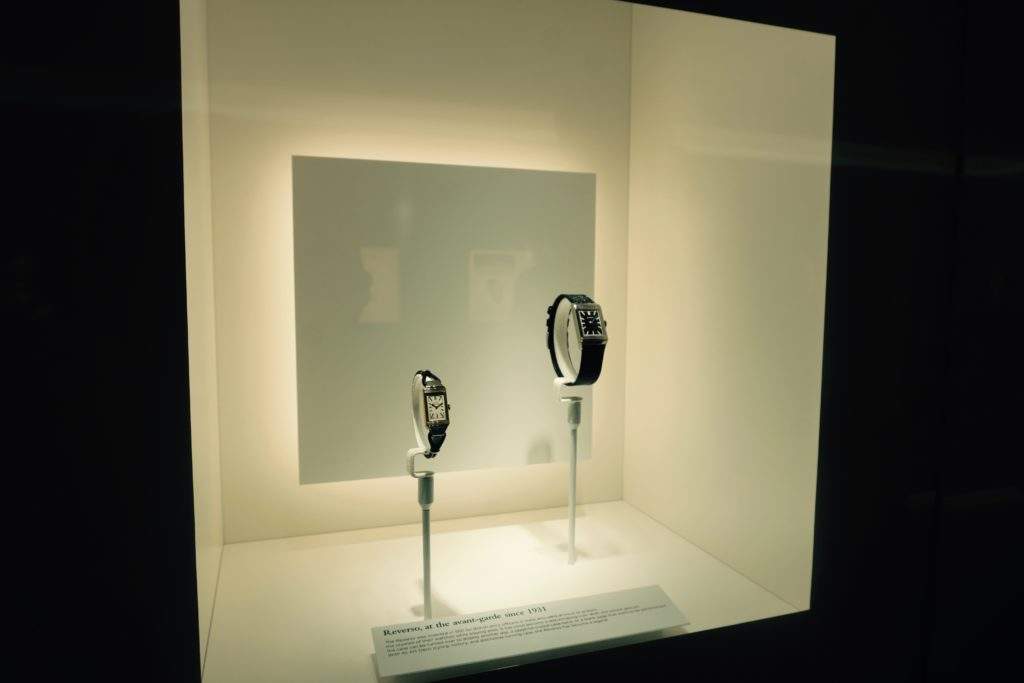
Let us look at the wonderful original 1931 Reverso that sits in the window, above right in more detail below.
It is Icon of design, a study of perfect simplicity and perfect functionality. It is one of my favourite watches of all time and am fortunate to own one from 1937.
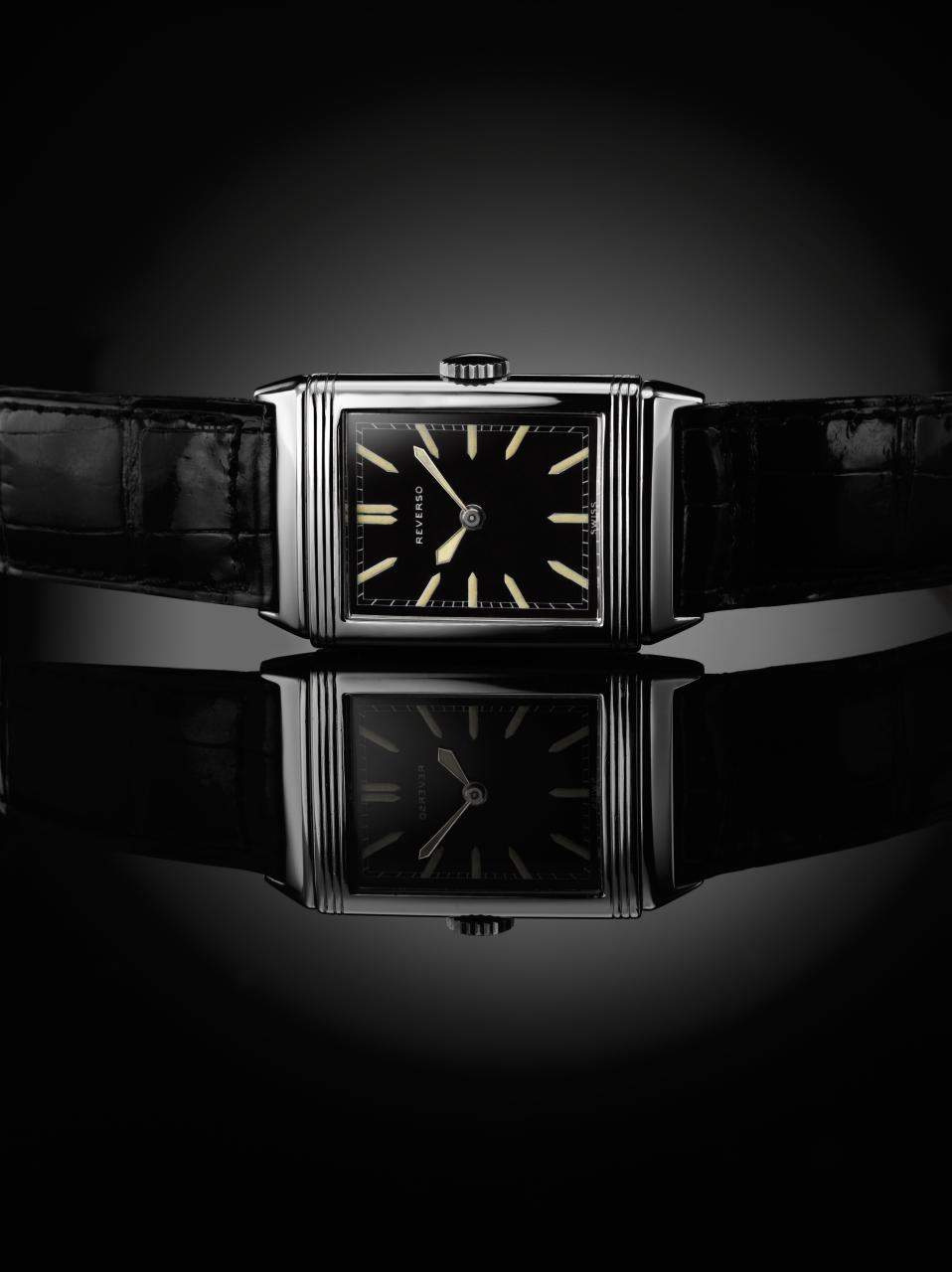
(Credit: Jaeger-LeCoultre).
The most famous Reverso that sits in the Museum is the one that belonged to General Douglas McArthur.
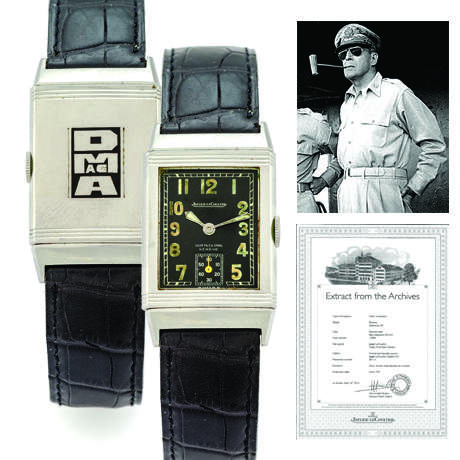
(Credit: Antiquorum).
The 1950s would bring big changes in watches – including for Jaeger.
Watches became more tool watches that had a function and were not just used for telling time. Here two iconic models, on the left the Memovox (one of the first alarm wristwatches) and the Futurematic, where Jaeger presented the world with the innovative concept of eliminating the winding crown through use of their automatic movement.
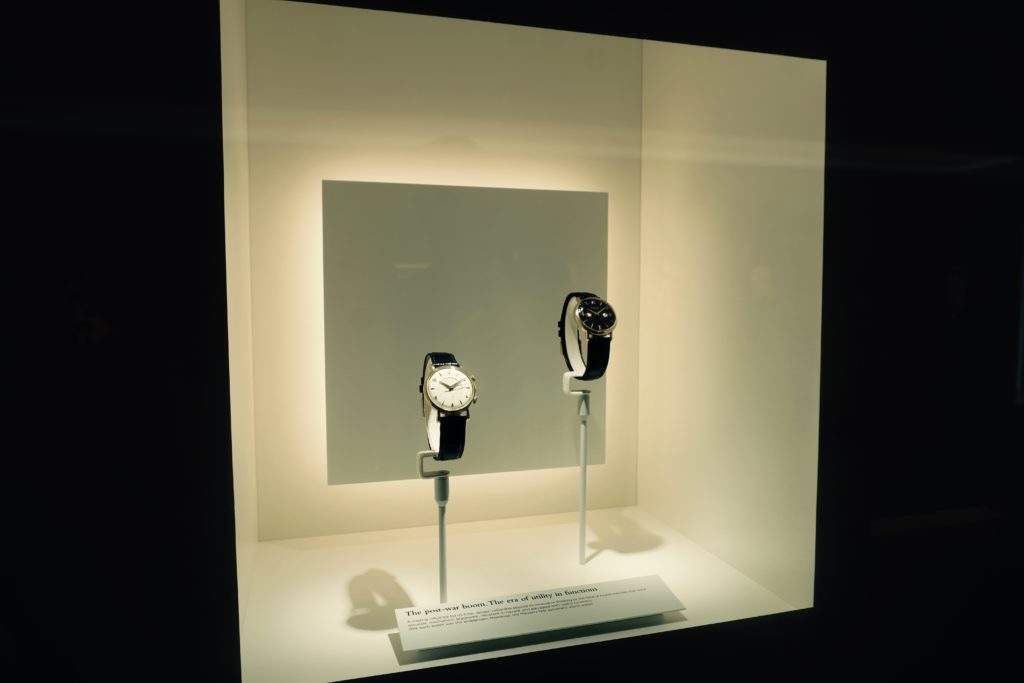
Let us take a closer look at the Futurematic of Jaeger-LeCoultre, the watch above right in more detail below. Notice the absence of the winding crown (private collection JLC Museum).
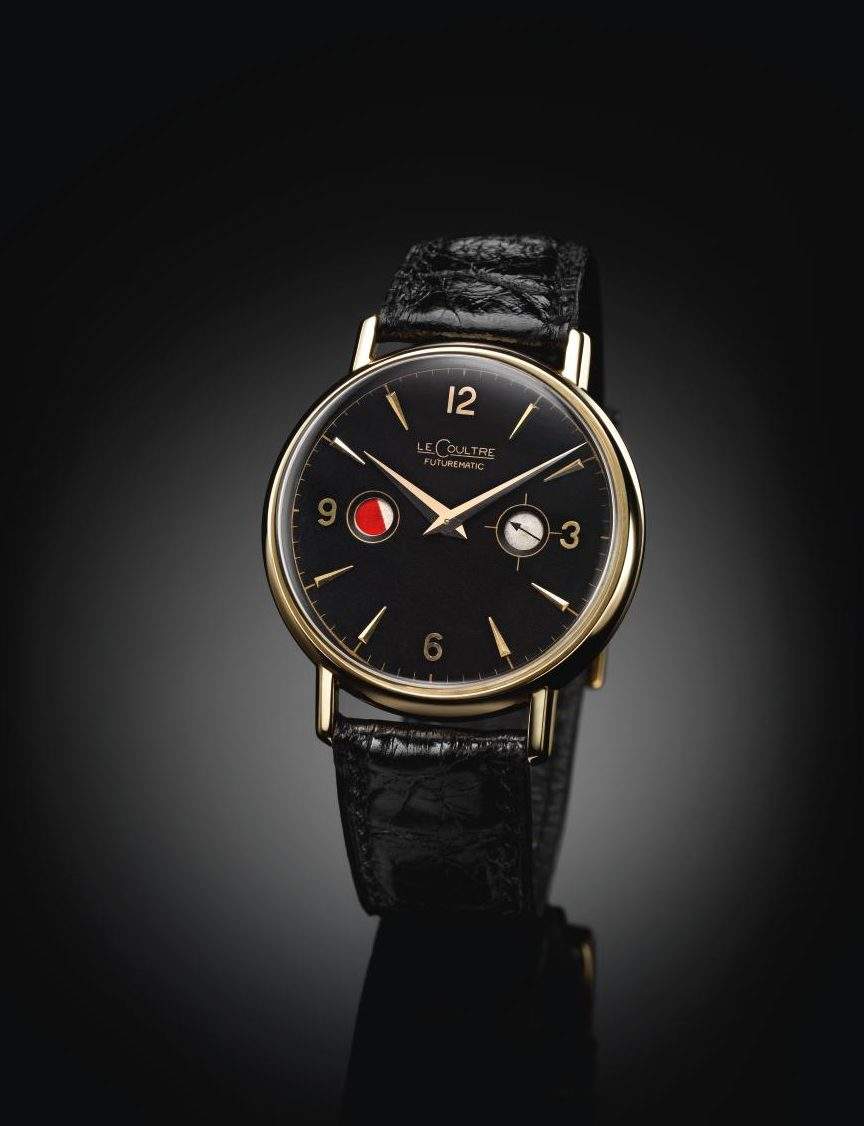
(Credit: Jaeger-LeCoultre).
Another legendary watch: The Deep Sea Alarm (DSA) by LeCoultre, the first diving watch to have an alarm for use under water. The model below is owned by the museum.
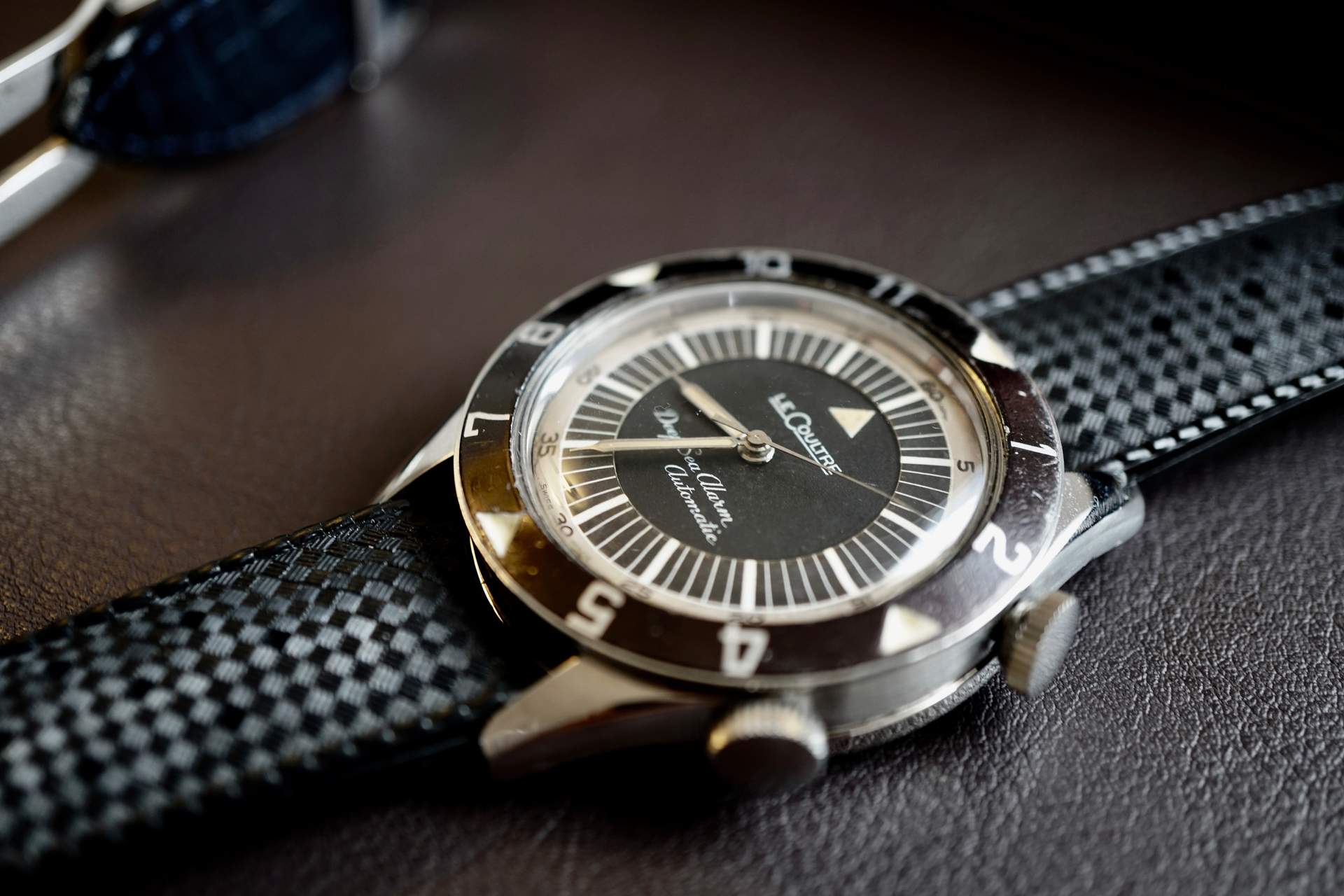
The DSA also was made for the European market below. Below the watch that also sits in the Museum of JLC.
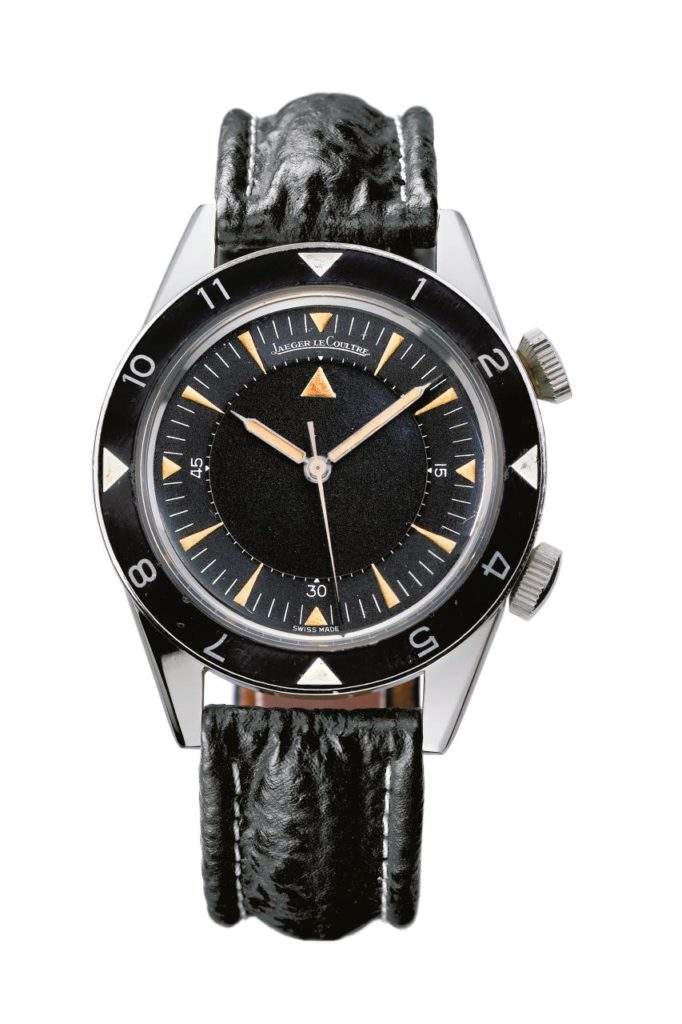
The last watch of interest shown in the gallery was the Polaris (watch on the right below) introduced in 1968, another diving watch that is an Icon today.
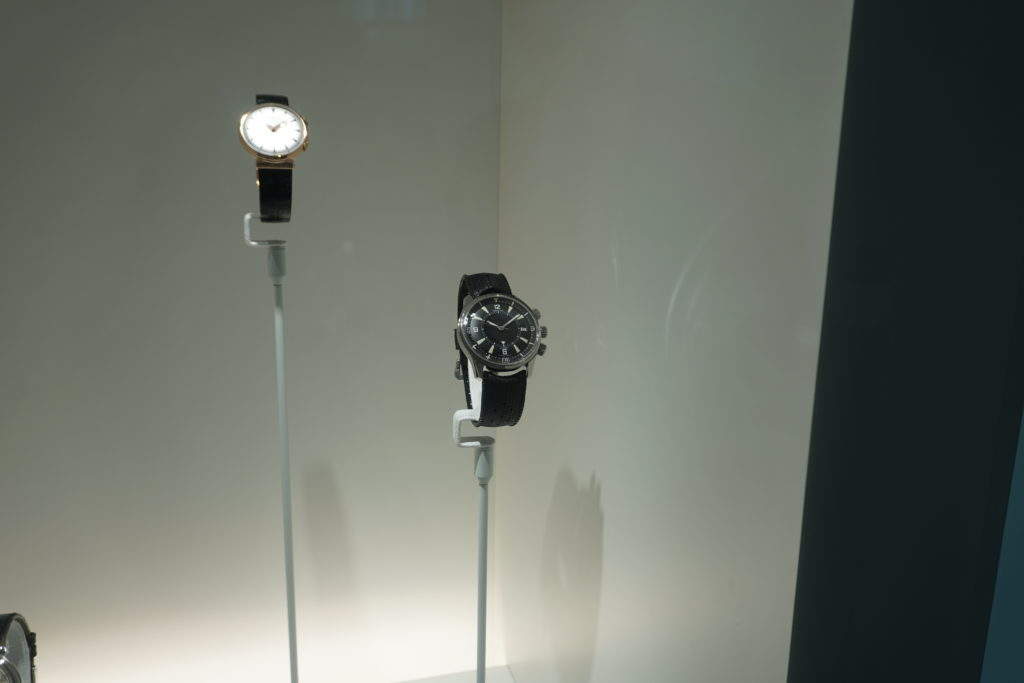
A close-up of the watch on the right above, below in more detail. It is one of my favourite watches and I am lucky to also own example.
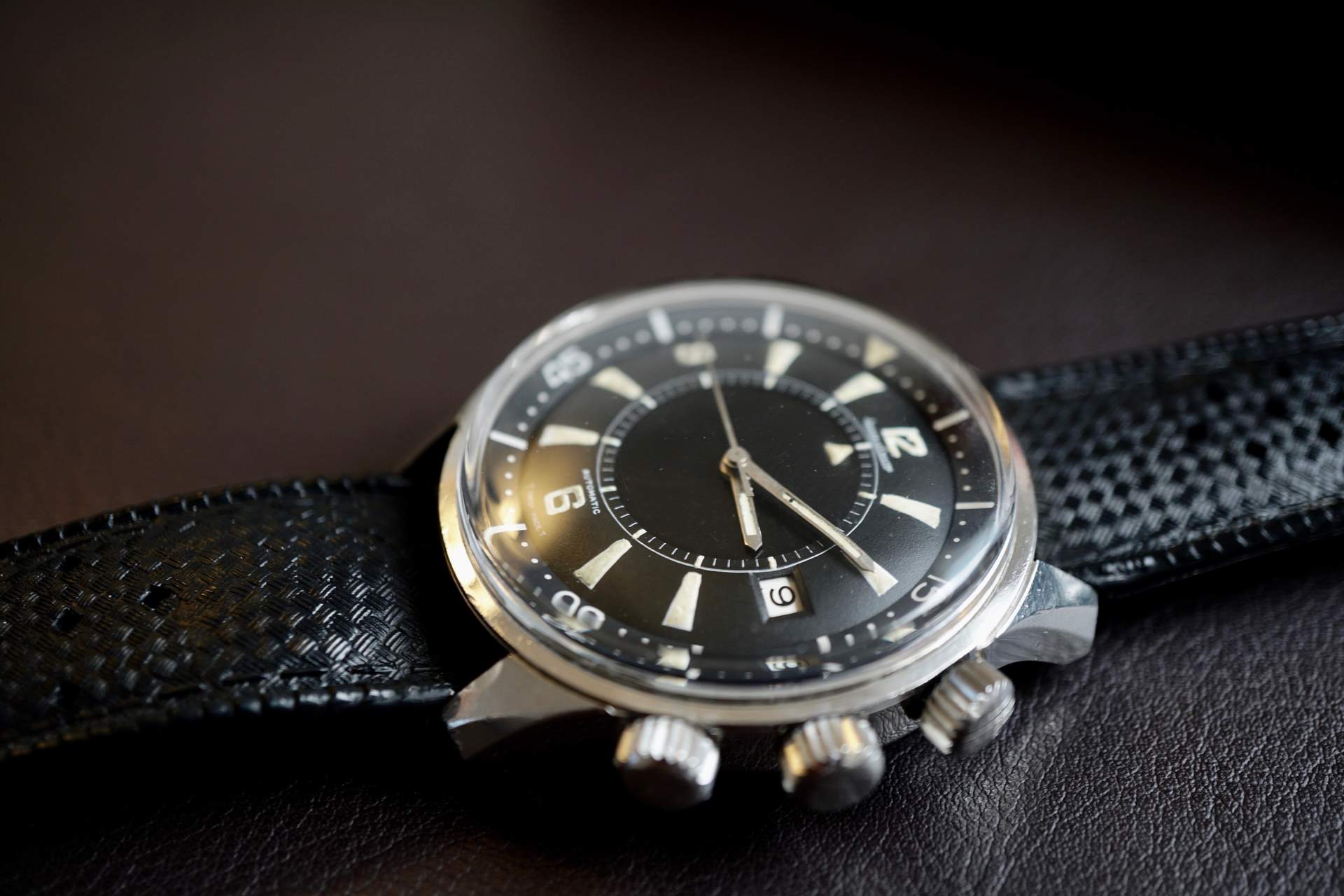
After the museum gallery, we went upstairs where Mr Belmont arranged a collection of stunning vintage Reverso, all from the early period, for me to look at in more detail.
Bright lacquer red anyone?
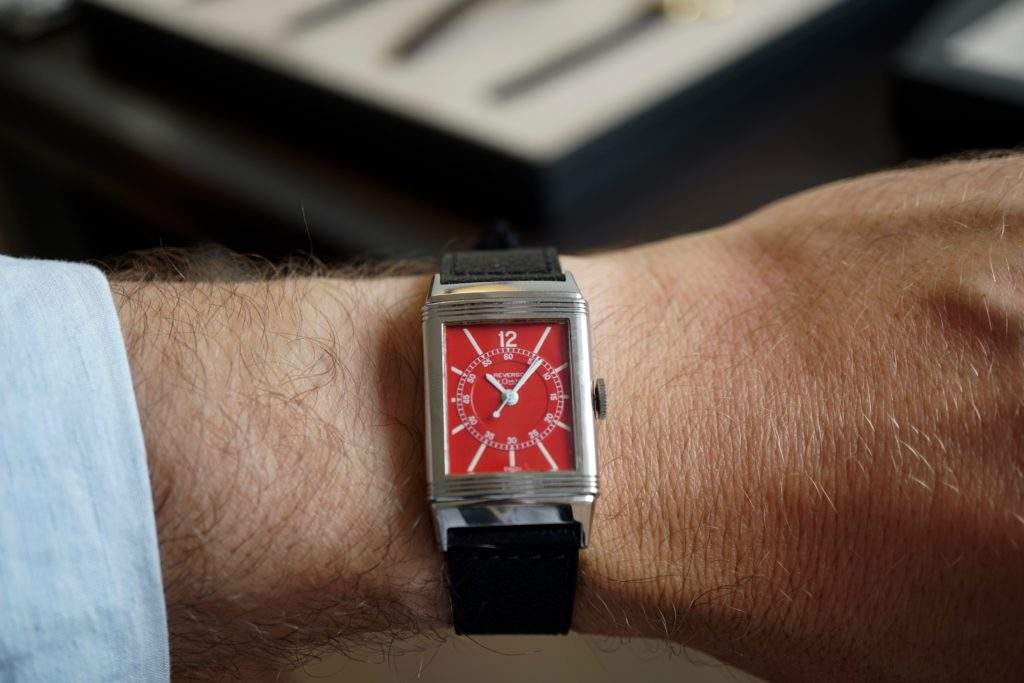
Only very few notice this – but the case of the Reverso is slightly curvex in shape.
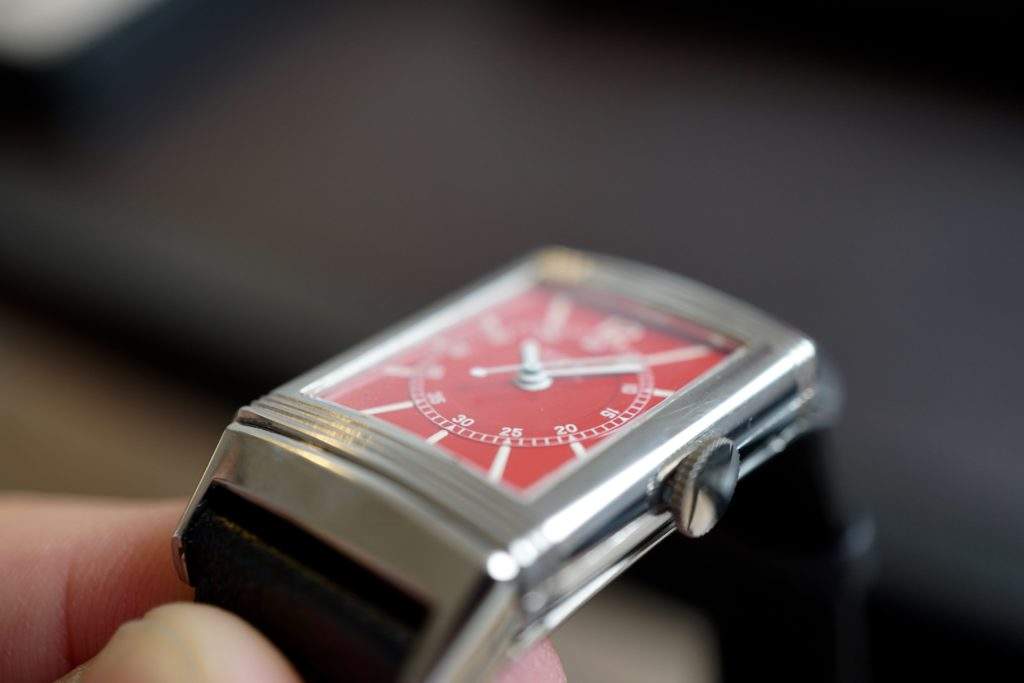
Here another dream Reverso with a red lacquer dial. Only the Reverso writing suggests that the watch below is among the earliest Reverso made (circa around 1931).
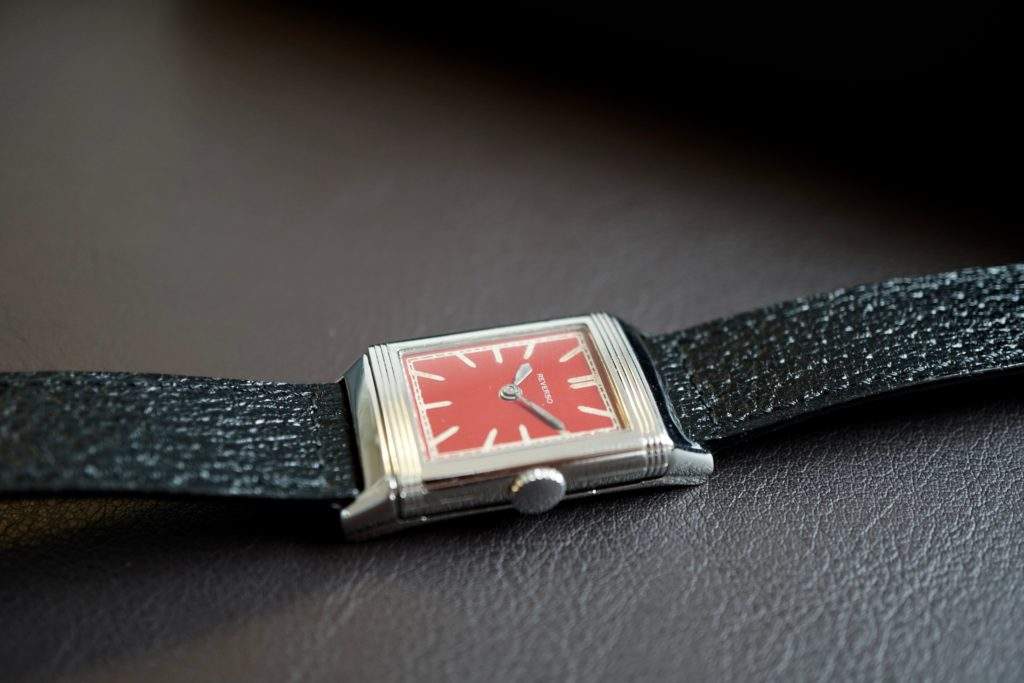
Reverso watches were also very popular for women. Below a Reverso for women on the left from circa 1935; men model is on the right is from 1945.
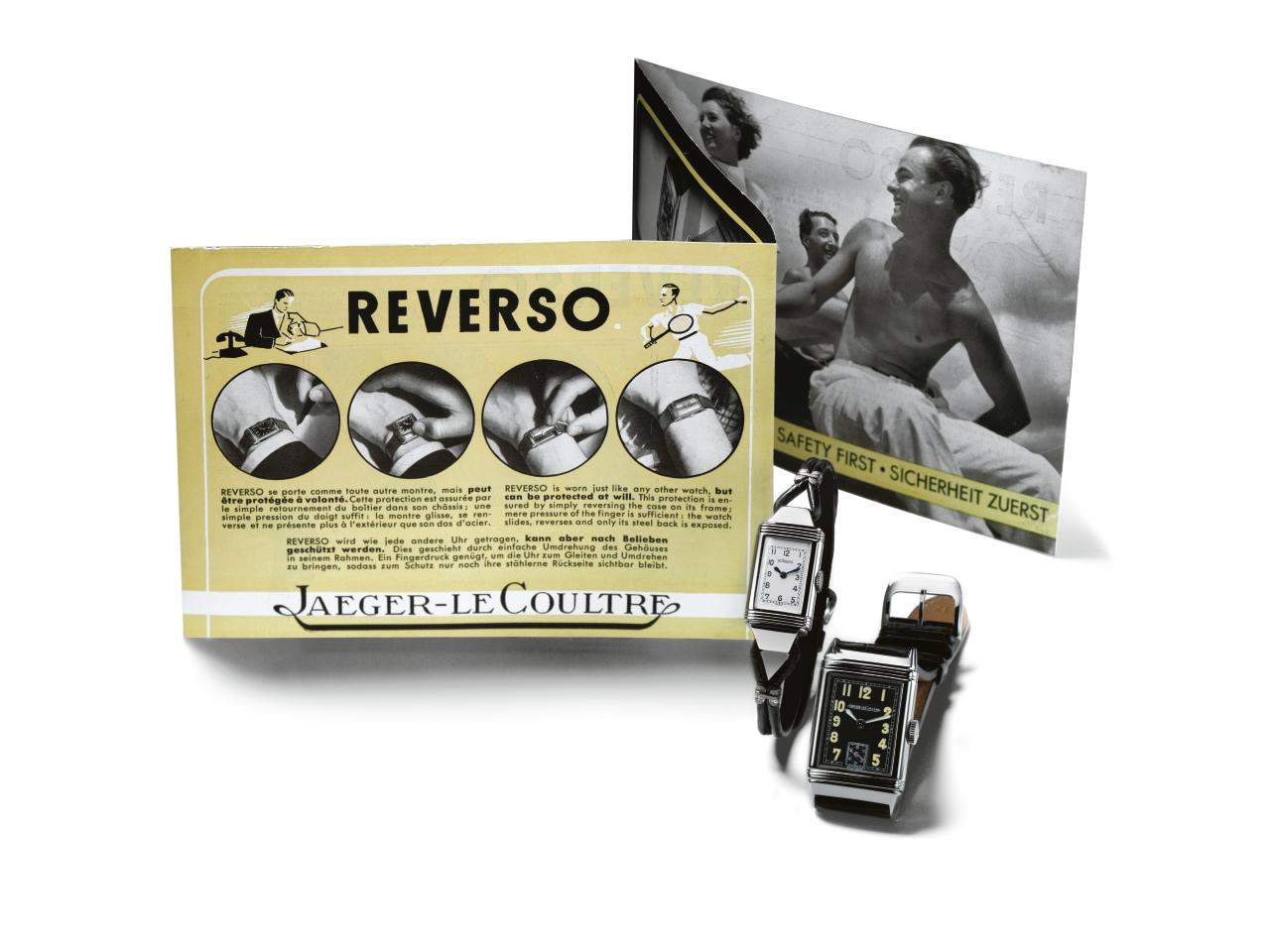
(Credit: Jaeger-LeCoultre).
The Reverso was an Icon for Jaeger-LeCoultre. Below another old advertisement from 1940.
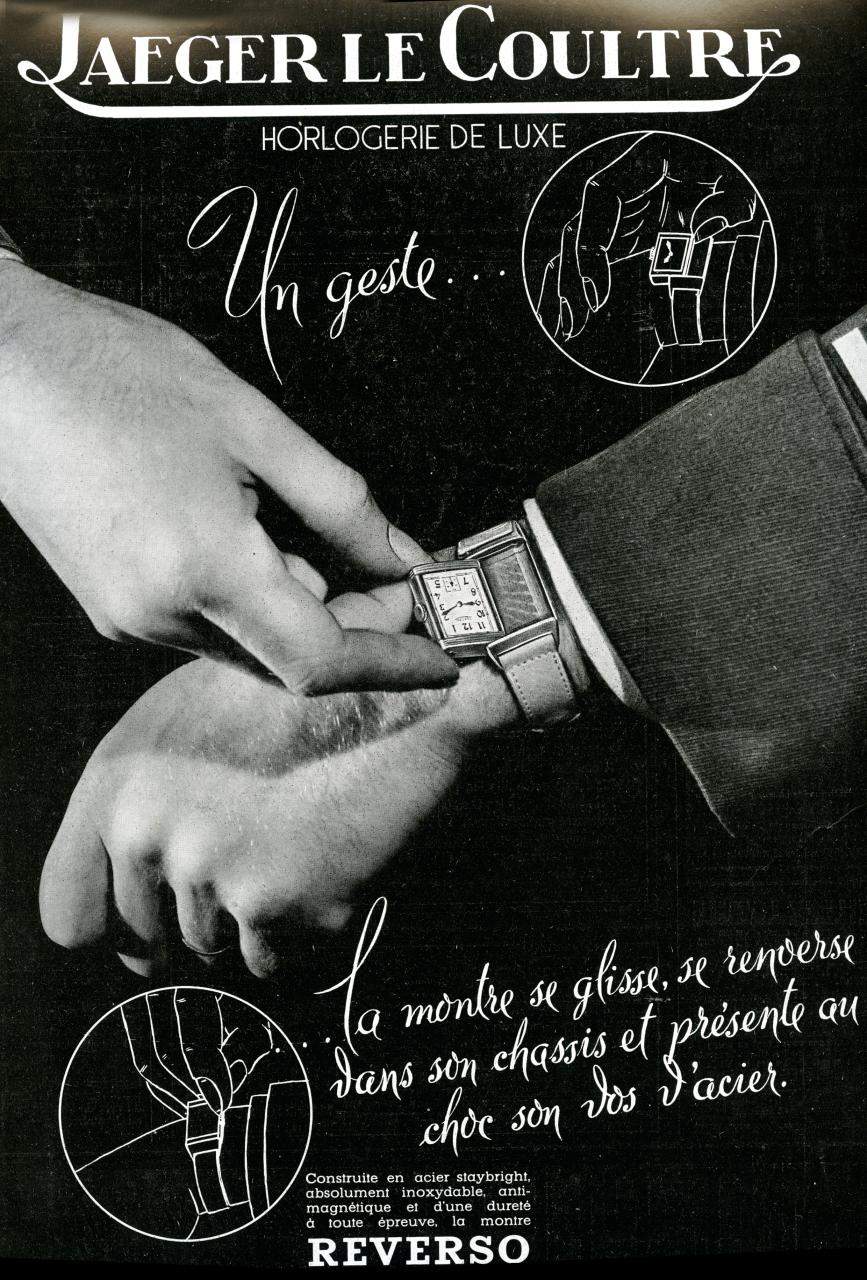
(Credit: Jaeger-LeCoultre).
Below a magnificent blue dial Reverso with unusual numerals on the dial. Also owned by the Jaeger museum heritage department.
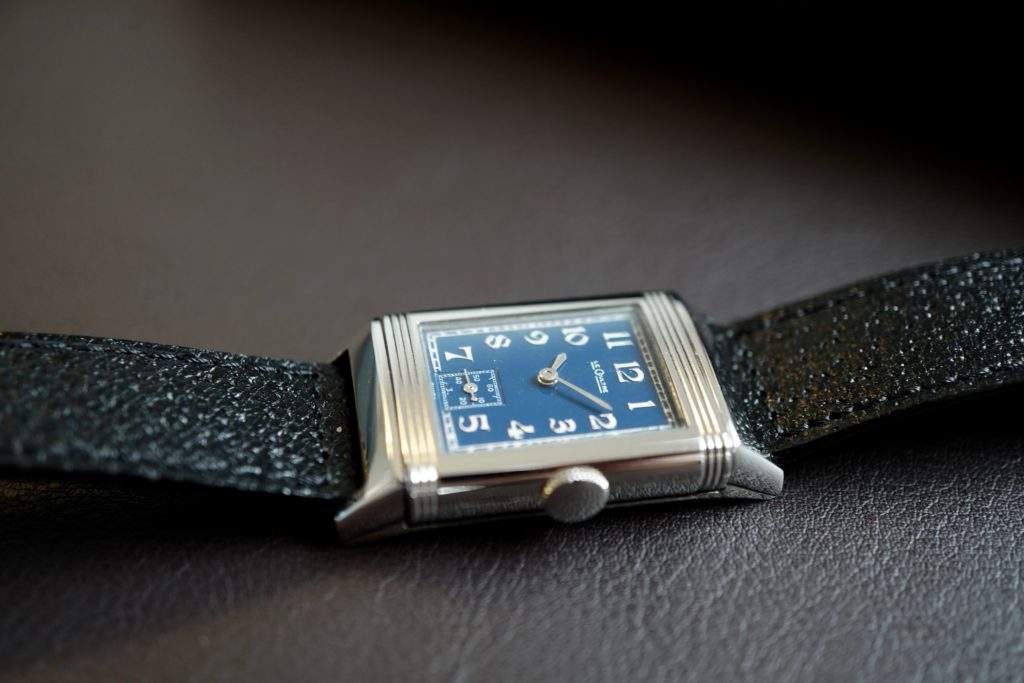
Here a different dial layout, but staying with the blue color.
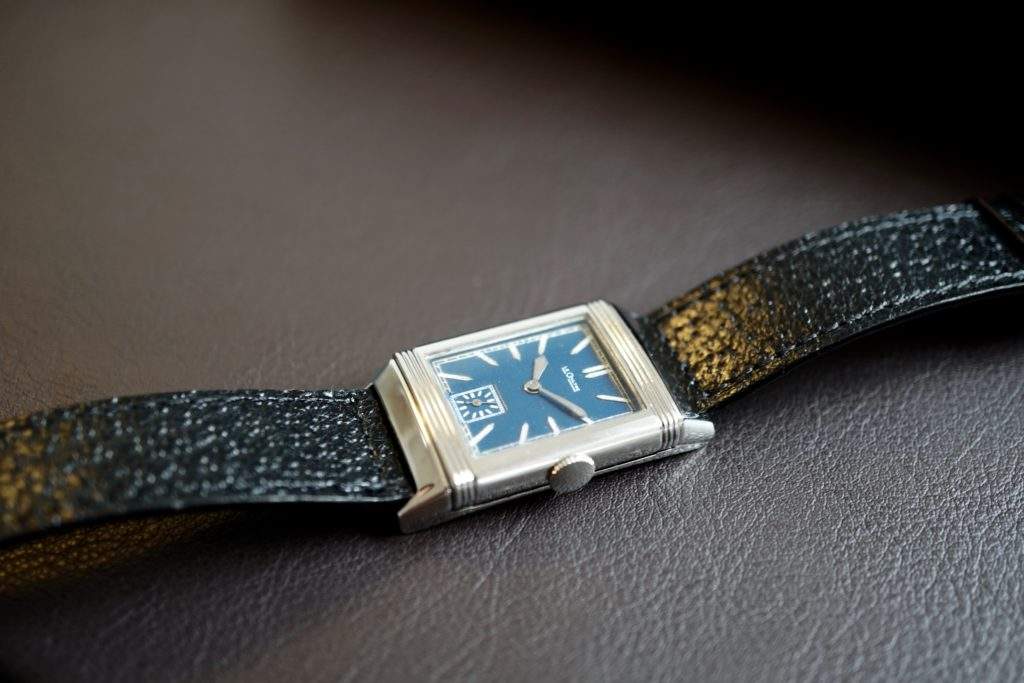
(Credit: Jaeger-LeCoultre).
Ever wondered how the movement looks like, that powers the Reverso? Here you go. Movement calibre 411 (one of 340 calibres that are on display at the museum out of total 1262 ever made).
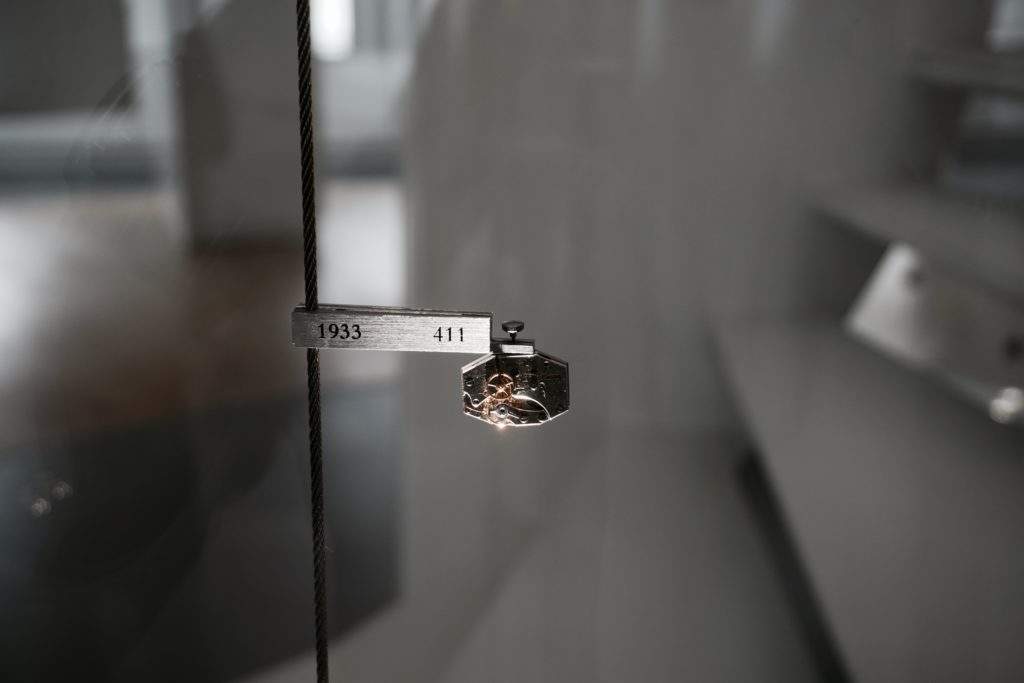
It was time to go. Outside a tribute to Antoine Le Coultre – the founder of what would become known as Jaeger-LeCoultre.
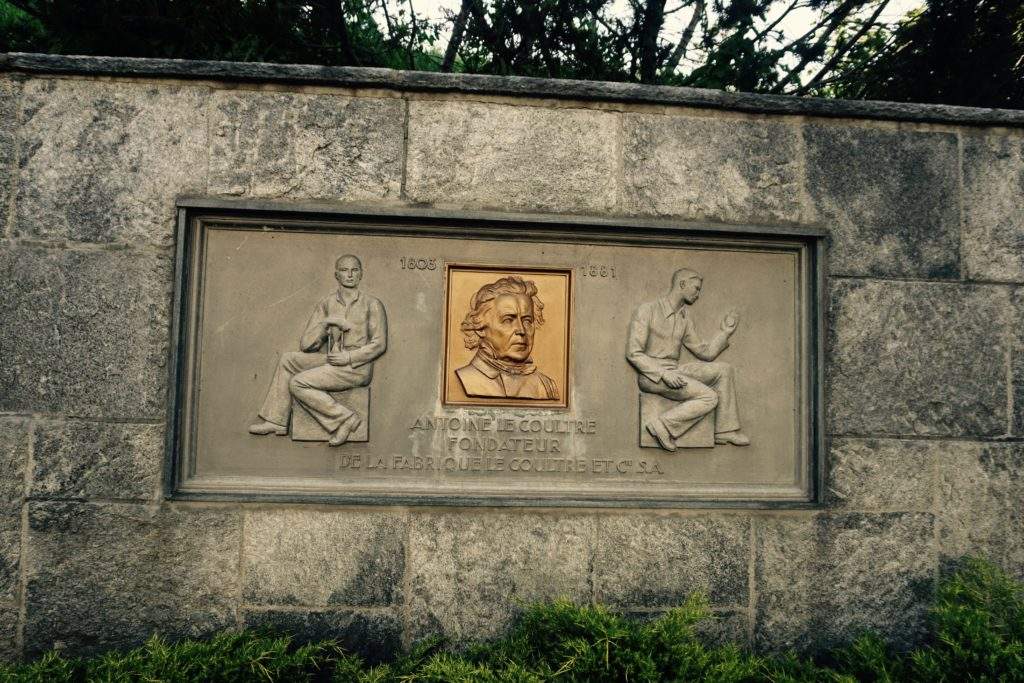
I noticed a swarm of bees nearby and realised this must be a bee hive. Yes – Jaeger even makes their own honey (would be delighted to try some on my next visit).

Thank you to Mr. Belmont (picture below) and Cecile for all their work and passion for the great brand that is Jaeger-LeCoultre!

(Credit: Jaeger-LeCoultre).
Full disclosure: I love the brand that is Jaeger-LeCoultre and am lucky to own three nice watches. A 1937 Reverso, a 1968 Polaris and a 2001 Pink Gold Reserve du Marche.
